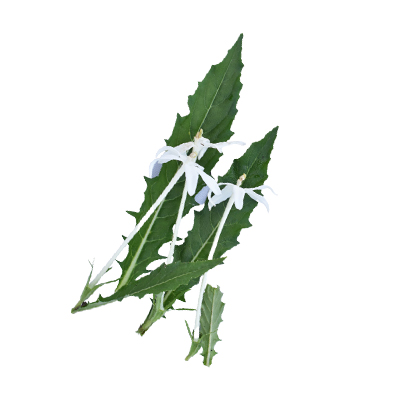Star of Bethlehem
Hippobroma longiflora (L.) G.Don
Campanulaceae
Location in our garden
Principal



Synonym
Isotoma longiflora (L.) C.Presl
Isotoma longiflora var. runcinata (Hassk.) Panigrahi. P.Daniel & M.V.Viswan
Isotoma runcinata Hassk.
Habitus
Herbaceous. A low annual to perennial herb, erect, spreading, branched or simple, about 30-50 cm high
Part Used
Leaves
Flowers
Growing Requirements
Need Shade
Habitat
Roadside
Grassland
Overview
Star of bethlehem is native to Jamaica but has been naturalized in the Americas and Oceania's tropics. The botanical name Hippobroma means horse madness, a herb with toxic milky sap, referring to the toxin that drives horses insane. Harvested from the wild for local medicinal use, the plant is sometimes grown for ornamental and medicinal purposes.
Vernacular Names
Tapak leman (Indonesia), Ma zui cao (Chinese), Etoile de Bethleem (French),Udel ra badrei (Hawaiian), Bunga bintang (Malay), Lagrimas de San Diego (Spanish), Fetia (Tahitian).
Agroecology
This species lives in open areas, mostly at the edge of streams of water, but naturalized in different tropical countries, often found along drains, rice paddies, wet, sheltered banks and along paths and roadsides in artificial soils overlapping with calcareous at altitudes of 60-810 m. This plant grows both in full sun and in partial shade in the tropical and humid subtropical climate zones, and is not unique to the soil, even if it is weak.
Morphology
- Stems - erect, spreading, branched or simple, smooth or slightly hairy, 30-50 cm high.
- Leaves - alternate, soft, and counterbalance, with short stalks or without stalks, 10 to 20 cm long, with serrate margins, narrow at both ends, pointed at the tip.
- Flowers - fragrant, white, five-lobed and star-shaped, borne singly at the axis of leaves. Calyx is green, 5-angled, and ovoid; tube is about 1 cm long. Five lobes are linear, inarticulate, about 1.5 cm long. Corolla is white; tube is slender, 8 to 10 cm long; the lobes spreading, cancelate, and 2.5 cm long. Capsule is nodding, about 2 cm long, and slightly protruding from the calyx-tube.
- Fruits - ellipsoid or obovoid bilicular capsules, villous, 1-1,5 cm long and 0,8-1,2 cm of diameter, containing several seeds almost ovoid 0,7 mm long, of pale brown color.
Cultivation
- Propagated by seeds, stem cuttings or saplings.
Chemical Constituents
- Alkaloid compounds (lobelin, lobelamin, isotomin), saponins, flavonoids (spirohexan, acetaldehyde), polyphenol, terpenoids, steroids, tannins, hexanedioic acid, acetophenone, squalene, silicic acid.
Traditional Medicinal Uses
- Leaves and flowers are considered antipyretic and decongestant.
- Considered anti-inflammatory, anti-neoplastic, analgesic, and hemostatic, anti-bacterial, tracheal smooth muscle relaxation activities.
- Aching teeth counter-irritant: the leaves are cleaned, pounded, and rubbed on painful carious teeth.
- The whole plant in Yucatan is used for wounds and venereal disease, asthma, bronchitis, and epilepsy.
- A decoction of the leaves for cleaning wounds, asthma, cancer, bronchitis.
- Antipyretic and decongestant leaves and flowers are considered. Used for diarrhea and gaseous distention.
- Leaf poultice is applied to wounds and wrapped.
- For the treatment of wounds and eye disorders in Indonesia.
- The Kutaian community uses the plant for kidney stones to improve endurance and vitality in East Kalimantan, Indonesia.
- The leaves are pressed in water for cataracts, and the solution is used as eye drops.
- Leaves, roots, and whole plant preparations are used internally and externally for snake bites, In Nicaragua.
Part Used
Reference Sources
- Farmasi UGM. (2008). Ki Tolod (lsotoma longiflora Presi.). https://ccrc.farmasi.ugm.ac.id/en/?page_id=125. (Accessed 14-12-2020).
- Fern, Ken. (2019). Useful Tropical Plant. Hippobroma longiflora (L.) G.Don. http://tropical.theferns.info/viewtropical.php?id=Hippobroma+longiflora. (Accessed 14-12-2020).
- Monaco Nature Encyclopedia. (No date). Hippobroma longiflora. https://www.monaconatureencyclopedia.com/hippobroma-longiflora-2/?lang=en. (Accessed 14-12-2020).
- StuartXchange. (2019). Philippine Medicinal Plants. Isotoma longiflora. http://www.stuartxchange.org/Estrella.html. (Accessed 14-12-2020).
- Royal Botanic Gardens. 2020. Hippobroma longiflora (L.) G.Don. http://www.plantsoftheworldonline.org/taxon/urn:lsid:ipni.org:names:1133957-2. (Accessed 14-12-2020).

